英语句子分类讲解与专项练习教程文件
初中英语句子结构讲解及练习题教案

初中英语句子结构讲解及练习题教案第一章:英语句子的基本结构1.1 介绍英语句子的基本结构,包括主语、谓语和宾语。
1.2 解释简单句、并列句和复合句的概念。
1.3 举例说明不同类型的句子结构。
第二章:名词性从句2.1 介绍名词性从句的概念和用途。
2.2 解释宾语从句、定语从句和同位语从句的区别。
2.3 提供名词性从句的练习题,让学生进行实际操作。
第三章:形容词性从句3.1 介绍形容词性从句的概念和用途。
3.2 解释定语从句和状语从句的区别。
3.3 提供形容词性从句的练习题,让学生进行实际操作。
第四章:副词性从句4.1 介绍副词性从句的概念和用途。
4.2 解释状语从句和补语从句的区别。
4.3 提供副词性从句的练习题,让学生进行实际操作。
第五章:句子的一致性5.1 介绍句子的一致性概念和重要性。
5.2 解释主谓一致和动宾一致的原则。
5.3 提供句子一致性的练习题,让学生进行实际操作。
第六章:情态动词句型6.1 介绍情态动词的概念和用法。
6.2 解释情态动词在不同句型中的搭配,如疑问句、否定句和条件句。
6.3 提供情态动词句型的练习题,让学生进行实际操作。
第七章:被动语态7.1 介绍被动语态的概念和用途。
7.2 解释被动语态的构成和用法。
7.3 提供被动语态的练习题,让学生进行实际操作。
第八章:虚拟语气8.1 介绍虚拟语气的概念和用途。
8.2 解释虚拟语气的构成和用法,包括现在虚拟、过去虚拟和将来虚拟。
8.3 提供虚拟语气的练习题,让学生进行实际操作。
第九章:句子转换9.1 介绍句子转换的概念和重要性。
9.2 解释将陈述句转换为疑问句、感叹句和祈使句的方法。
9.3 提供句子转换的练习题,让学生进行实际操作。
第十章:综合练习与提高10.2 设计一些较难的练习题,让学生进行挑战。
10.3 提供一些实际语境的练习题,让学生学会在实际情境中运用所学的句子结构。
重点和难点解析一、名词性从句难点解析:名词性从句中的宾语从句、定语从句和同位语从句在句子中的功能和位置不同,学生需要理解并区分它们。
英语句子成分及练习课件
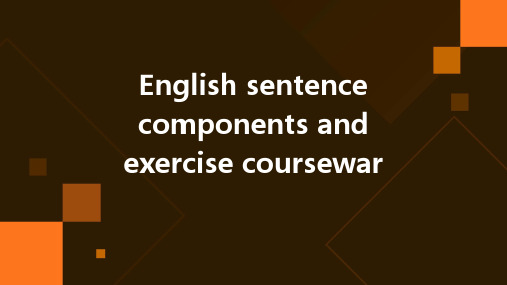
Attributive Exercises
04
The Application of Sentence Elements in Writing
Subjects should be clear and specific
When selecting a subject for a presence, it is important to choose one that is clear and specific enough to consider the intended meaning Avoiding using vague or ambiguous subjects that could lead to fusion
Summary word
The topic is the core of the sentence, usually appearing at the beginning of the sentence, and is the object described by the sentence. For example, the "cat" in "The cat sat on the mat." is the theme.
Complex senses
03
Sentence Component Exercise
Master the role and position of the subject in a sentence
The subject is the main component of a sentence, usually appearing at the beginning of the sentence to express the object described in the sentence. Through practice, learners should be able to recognize and use the subject correctly, ensuring correct sentence grammar.
英语句子的种类及练习课件 (1)

By the time he arrived, 1 主句 we had already left. 2
在复合句中,根据从句所充当的成分的 不同,可分为以下类型从句: 主语从句 名词性句
宾语从句
表语从句 同位语从句
状语从句
定语从句
中学生英文写作中经常 使用的从句有:
1. 宾语从句
2. 状语从句
3. 定语从句
while
请用合适的并列连词把每组句子 合并为一个并列句。 1.He was tired. He went to bed.
He was tired, so he went to bed.
2.The child hid behind his mother's skirt. He was afraid of the dog.
有下划线的词叫从属连词
(subordinating conjunction)
I’ll give the letter to him when I see him. He didn’t come yesterday because he was ill. It is such a big box that nobody can move it. We’ll go to the great wall if it’s fine tomorrow. Although the place is quite pleasant, we should not go there all the time.
练习二、简单句、并列句和复合句
一We often study Chinese history on Friday afternoon. 简单句 2. The boy who offered me his seat is called Tom. 复合句 简单句 3. There is a chair in this room, isn’t there? 4. My brother and I go to school at half past seven in the morning and come back home at seven in the evening. 简单句
(完整word版)英语句子类型讲解及练习
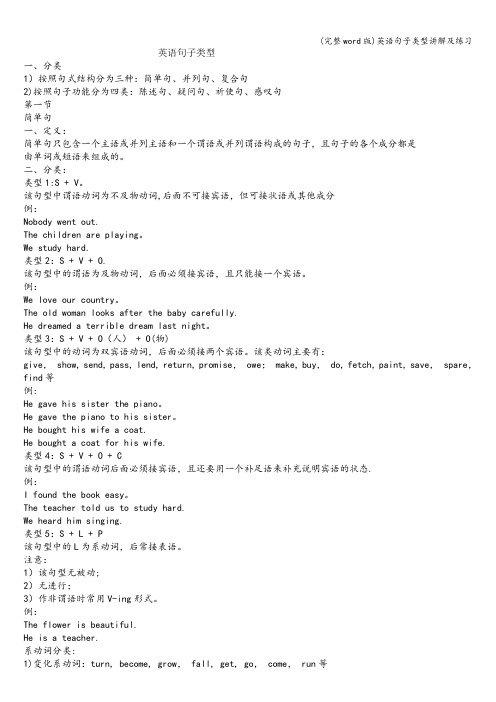
英语句子类型一、分类1)按照句式结构分为三种:简单句、并列句、复合句2)按照句子功能分为四类:陈述句、疑问句、祈使句、感叹句第一节简单句一、定义:简单句只包含一个主语或并列主语和一个谓语或并列谓语构成的句子,且句子的各个成分都是由单词或短语来组成的。
二、分类:类型1:S + V。
该句型中谓语动词为不及物动词,后面不可接宾语,但可接状语或其他成分例:Nobody went out.The children are playing。
We study hard.类型2:S + V + O.该句型中的谓语为及物动词,后面必须接宾语,且只能接一个宾语。
例:We love our country。
The old woman looks after the baby carefully.He dreamed a terrible dream last night。
类型3:S + V + O(人) + O(物)该句型中的动词为双宾语动词,后面必须接两个宾语。
该类动词主要有:give, show, send, pass, lend, return, promise, owe; make, buy, do, fetch, paint, save, spare,find等例:He gave his sister the piano。
He gave the piano to his sister。
He bought his wife a coat.He bought a coat for his wife.类型4:S + V + O + C该句型中的谓语动词后面必须接宾语,且还要用一个补足语来补充说明宾语的状态.例:I found the book easy。
The teacher told us to study hard.We heard him singing.类型5:S + L + P该句型中的L为系动词,后常接表语。
英语句子成分和英语句子结构讲解及练习
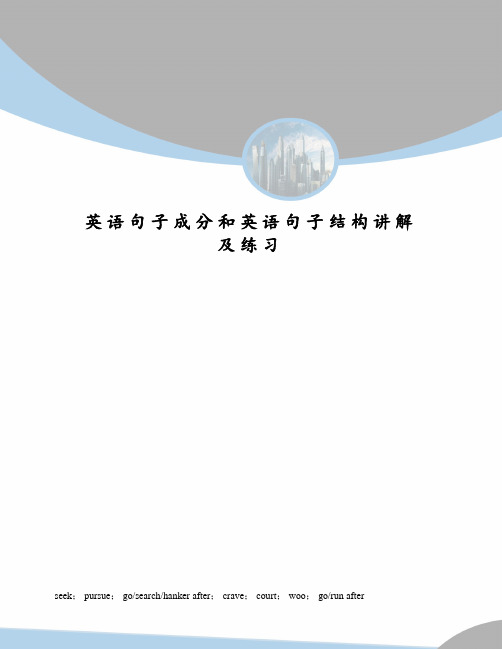
英语句子成分和英语句子结构讲解及练习seek; pursue; go/search/hanker after; crave; court; woo; go/run after英语句子成分和英语句子结构讲解及练习简单句的五个基本句型主语+不及物动词Shecame..主语+及物动词+宾语ShelikesEnglish.主语+系动词+主语补语Sheishappy.主语+动词+间接宾语+直接宾语ShegaveJohnabook.Sheboughtabookforme.主语+动词+宾语+宾语补语Shemakeshermotherangry.Theteacheraskedmetoreadthepassage.There+beThereliesabookonthedesk.主谓宾名/代--动词--名/代we--saw--you.we--did--thework.主系表名/代-系动词-形容次/名词/代词youarebeautifulyouseemsworried.youareastufent.相同点都三部分,主语也一样.不同动词和系动词,时态一样,否定式不同.动词加助动词,系动词不用.表语可以是形容词,宾语不行.只有宾语有补足语2、句子成分:英语句子成分分为七种:主语、谓语、宾语、定语、状语、表语、宾语补足语.1、主语是句子所要说的人或事物,回答是“谁”或者“什么”.通常用名词或代词担任.如:I’mMissGreen.我是格林小姐2、谓语动词说明主语的动作或状态,回答“做什么”.主要由动词担任.如:Jackcleanstheroomeveryday.杰克每天打扫房间3、表语在系动词之后,说明主语的身份或特征,回答是“什么”或者“怎么样”.通常由名词、代词或形容词担任.如:MynameisPingping.我的名字叫萍萍4、宾语表示及物动词的对象或结果,回答做的是“什么”.通常由名词或代词担任.如:Hecanspelltheword.他能拼这个词有些及物动词带有两个宾语,一个指物,一个指人.指物的叫直接宾语,指人的叫间接宾语.间接宾语一般放在直接宾语的前面.如:Hewrotemealetter.他给我写了一封信有时可把介词to或for加在间接宾语前构成短语,放在直接宾语后面,来强调间接宾语.如:Hewrotealettertome.他给我写了一封信5、定语修饰名词或代词,通常由形容词、代词、数词等担任.如:Shanghaiisabigcity.上海是个大城市6、状语用来修饰动词、形容词、副词,通常由副词担任.如:Heworkshard.他工作努力7、宾语补足语用来说明宾语怎么样或干什么,通常由形容词或动词充当.如:Theyusuallykeeptheirclassroomclean.他们通常让教室保持清洁/Heoftenhelpsmedomylessons.他常常帮我做功课/ TheteacherwantedmetolearnFrenchallbymyself.老师要我自学法语8☆同位语通常紧跟在名词、代词后面,进一步说明它的情况.如:WhereisyourclassmateTom你的同学汤姆在哪里1.主语subject:句子说明的人或事物.Thesunrisesintheeast名词Helikesdancing.代词Twentyyearsisashorttimeinhistory.数词Seeingisbelieving.动名词Toseeistobelieve.不定式Whatheneedsisabook.主语从句Itisveryclearthattheelephantisroundandtalllikeatree.It形式主语,主语从句是真正主语一指出下列句中主语的中心词①Theteacherwithtwoofhisstudentsiswalkingintotheclassroom.②Thereisanoldmancominghere.③Theusefuldictionarywasgivenbymymotherlastyear.④Todotoday'shomeworkwithouttheteacher'shelpisverydifficult.谓语predicate:是对主语加以陈述,表示主语的行为或状态,常用动词或者动词词组担任,放在主语的后面.WestudyEnglish.Heisasleep.二.选出句中谓语的中心词①Idon'tlikethepictureonthewall.A.don'tB.likeC.pictureD.wall②Thedaysgetlongerandlongerwhensummercomes.A.getB.longerC.daysD.summer③DoyouusuallygotoschoolbybusA.DouallyC.goD.bus④Therewillbeameetingatthelibrarythisafternoon.A.willbeB.meetingC.thelibraryD.afternoon3.表语predicative:系动词之后的成分,表示主语的性质、状态和特征.Heisateacher.名词Youdon’tlook it.代词Fiveandfiveisten.数词Heisasleep.形容词Hisfatherisin.副词Thepictureisonthewall.介词短语Mywatchisgone/missing/lost.形容词化的分词Thequestioniswhethertheywillcome.表语从句常见连系动词“存在”类:表示存在或具有某种特征或状态.这类连系动词强调“存在”.常见的有:be是,look看起来,feel摸上去,seem似乎是,appear似乎、显得,prove证明是,smell闻起来,taste尝起来,sound听起来等.例如:Thestorysoundstrue.Thoseorangestastegoodstar.2.“持续”类:表示某种情况或状态的持续.这类连系动词强调“持续”.常见的有:remain依然,keep保持,stay保持,continue继续、仍旧,stand处于某状况或情形等.例如:Whydon'tyouputthemeatinthefridgeItwillstayfreshforseveraldays.It'salreadyteninthemorning.Thestoreremainsclosed.What'sthematter3.“变化”类:表示由一种情况或状态变化成另一种情况或状态.这类连系动词强调“变化”后的情况或状态.常见的有:become变成,turn变成,grow变得,get变得等.例如:Putthefishinthefridge,oritwillgobadinhotweather.三挑出下列句中的表语①Theoldmanwasfeelingverytired.②WhyisheworriedaboutJim③Theleaveshaveturnedyellow.④SoonTheyallbecameinterestedinthesubject.⑤Shewasthefirsttolearnaboutit.①tired ②worried ③yellow ④interested ⑤first4.宾语:1动宾表示行为的对象,常由名词或者代词担任.放在及物动词或者介词之后.如:IlikeChina.名词Hehatesyou.代词Howmanydoyouneed Weneedtwo.数词Ienjoyworkingwithyou.动名词Ihopetoseeyouagain.不定式Didyouwritedownwhathesaid宾语从句2介词后的名词、代词和动名词-----介宾AreyouafraidofthesnakeUnderthesnow,therearemanyrocks.3双宾语-----间宾指人和直宾指物Hegavemeabookyesterday.Givethepoormansomemoney四挑出下列句中的宾语①Mybrotherhasn'tdonehishomework.②PeopleallovertheworldspeakEnglish.③Youmustpaygoodattentiontoyourpronunciation.④Howmanynewwordsdidyoulearnlastclass⑤Someofthestudentsintheschoolwanttogoswimming.hishomework ②English ③yourpronunciation ④newwords ⑤togoswimming5.宾补:对宾语的补充,全称为宾语补足语.Weelectedhimmonitor.名词Weallthinkitapity thatshedidn’tcomehere.名词Wewillmakethemhappy.形容词Wefoundnobodyin.副词Pleasemakeyourselfathome.介词短语Don’tlethim dothat.省to不定式Hisfatheradvisedhimtoteachthelazyboyalesson.带to不定式Don’tkeepthelights burning.现在分词I’llhavemybike repaired.过去分词扩展:主补:对主语的补充.Hewaselectedmonitor.Shewasfoundsinginginthenextroom.Hewasadvisedtoteachthelazyboyalesson.五挑出下列句中的宾语补足语①Shelikesthechildrentoreadnewspapersandbooksinthereading-room.②Heaskedhertotaketheboyoutofschool.③Shefounditdifficulttodothework.④TheycallmeLilysometimes.⑤IsawMr.Wanggetonthebus.⑥DidyouseeLiMingplayingfootballontheplaygroundjustnow①toreadnewspapersandbooksinthereading-room ②totaketheboyoutofschool ③Lily ④getonthebus ⑤playingfootballontheplayground划出句中的直接宾语和间接宾语①Pleasetellusastory.②Myfatherboughtanewbikeformelastweek.③Mr.Liisgoingtoteachushistorynextterm.④Hereisapen.GiveittoTom.⑤Didheleaveanymessageforme6.定语:修饰或限制名词或代词的词、词组或句子.Yanlingisachemistryteacher.名词Heisourfriend.代词Webelongtothethirdworld.数词Hewasadvisedtoteachthelazyboyalesson.形容词Themanoverthereismyoldfriend.副词Thewomanwithababyinherarmsismysister.介词TheboysplayingfootballareinClass2.现在分词Thetreesplantedlastyeararegrowingwellnow.过去分词Ihaveanideatodoitwell.不定式YoushoulddoeverythingthatIdo.定语从句六挑出下列句中的定语①TheyuseMr.,Mrs.withthefamilyname.②Whatisyourgivenname③OnthethirdlapareClass1andClass3.④Iamafraidsomepeopleforgottosweepthefloor.⑤Themandownstairswastryingtosleep.①family ②given ③third ④some ⑤downstairs7.状语:用来修饰v.,adj.,adv.,or句子.表示时间、地点、原因、目的、结果、程度、条件、方式和让步.以下例句按上述顺序排列Iwillgotheretomorrow.Themeetingwillbeheldinthemeetingroom.Themeatwentbadbecauseofthehotweather.HestudieshardtolearnEnglishwell.Hedidn’tstudyhard sothathefailedintheexam.Ilikesomeofyouverymuch.Ifyoustudyhard,youwillpasstheexam.Hegoestoschoolbybike.Thoughheisyoung,hecandoitwell.七挑出下列句中的状语①Therewasabigsmileonherface.②Everynightheheardthenoiseupstairs.③HebegantolearnEnglishwhenhewaseleven.④Themanonthemotorbikewastravellingtoofast.⑤Withthemedicineboxunderherarm,MissLihurriedoff.①ontheface ②Everynight ③whenhewaseleven ④fast ⑤Withthemedicineboxunderherarm 八、同位语当一个概念词在前,后面的词、词组或者句子是在解释前者时,而且两者的语法功能相同,后者就是前者的同位语.Mr.Black,ourEnglishteacher,isagoodtennisplayer.我们的英语老师——布莱克先生是个优秀的网球手.Football,theonlyinterestinlife,hasbroughthimmanyfriends.足球----他唯一的爱好,让他结交了许多朋友.YesterdayImetTom,afriendofmybrother's.昨天我遇到了我弟弟的朋友汤姆.That’sherhabit,readinginbed.躺在床上看书是她的习惯.Yoursuggestion,tostrikewhiletheironishot,seemedagoodidea.你建议趁热打铁,这个建议很好. Hegaveordersthattheworkshouldbestartedimmediately.他发出指示要立即开始工作.Youstillhaven’tansweredmyquestionwhyyoudidn’tcometoschoolyesterday.你还没有回答我昨天为什么没有上学.同位语从句常跟在某些名词后,对其作进一步的解释.这些名词包括:fact,doubt,idea,news,hope,indication,decision,possibility,assumption,suggestion,ques tion.这类从句常常有that引导,有时也可以用what,why,whether,when等引导.九插入语插入语是说话者对所表达的意思的补充、强调、解释或者说话的态度,其位置灵活常常用逗号或者破折号分开,并且在语法上不影响其他成份.1.插入语常以副词副词短语、形容词形容词短语、介词短语、短语等形式出现.1常见的副词及短语:indeed,surely,however,obviously,frankly,naturally,luckily/happilyforsb.certainly等.九■Therebe句型拓展:Therebe+句词词组”中,there为虚词,be后面的名词词组为句子的真正主语.该句式在使用时须注意如下几点:★Therebe句式表示“有”时,它表示一种存在关系,通常带有一个地点状语,意为“什么地方时候有……”.句式中的主语只能为表泛指的名词词组,此外,其主语还可以带前置或后置定语.例如:1.Thereisablackboardintheclassroom.2.Therearefiveminutestogo.3.Therearetwooldwomenwaitingforyouatthegate.★在正式文体中,该句式中be动词的单复数形式取决于以下两种情况:1该句式中只有一个主语,主语为单数时,be动词用单数;主语若为复数,be动词也用复数.2该句式中有几个并列主语,则按就近原则处理,即与靠近be动词的第一个主语保持一致.例如:1.Thereisroomforimprovement.2.Therearethreeapplesonthetable.3.Therewereonlytwopens,adictionaryandatextbookonthedesk.★“Therebe+主语+不定式”中,不定式可以有主动和被动两种形式,不过在口语中主动形式更为常见.例如:1.Thereisalettertotypetoday.2.Thereisnotimetolose.3.Therearemanythingstobedonenow.★Therebe句式中,be动词有各种变化形式.1be动词有时态变化,可以为一般现在时、一般过去时、现在完成时、过去完成时、将来时等.例如:1.Therearealotofpeopleinthemeeting-room.2.Therewaslittleleft.3.Therehavebeenmanysuchtrafficaccidentsinthepastfewyears.4.Whenhegotthere,hefoundtherehadbeennoonewaitingforhimintheroom.5.Withoutair,therewouldbenolivingthings.6.Thereisgoingtobeastormtomorrowmorning.2Therebe句式中,be之前可以有情态动词.例如:1.Theremaybesomepeoplewhodon’tlikethefilm.2.Thereusedtobeatempleinthevillage.句子种类一按使用目的可分为陈述句、疑问句、祈使句和感叹句.1陈述句DeclarativeSentences:说明一个事实或陈述一种看法. Lighttravelsfasterthansound.光比声速度快.Thefilmisratherboring.这部电影很乏味.Ihaven’tgotacamera.我没有相机.Theyhavenevermetbefore.他们以前从没见过面.疑问句InterrogativeSentences:提出问题.有以下四种:a.一般疑问句GeneralQuestions:Canyoufinishtheworkintime你能按时完成工作吗b.特殊疑问句WQuestions;HQuestionsWheredoyoulive 你住那儿Howdoyouknowthat 你怎么知道那件事c.选择疑问句AlternativeQuestions:Doyouwantteaorcoffee你是要茶还是要咖啡d.反意疑问句Tag-Questions:Heknowsher,doesn’the他不认识她,对不对=Doesheknowheryes,hedoes.No,hedoesn’t.3祈使句ImperativeSentences:提出请求,建议或发出命令,例如:Sitdown,please.请坐.Don'tbenervous别紧张4感叹句ExclamatorySentences:表示说话人惊奇、喜悦、愤怒等情绪,例如:Whatgoodnewsitis多好的消息啊HowgoodthenewsisWhatbeautifulflowerstheyare多美丽的花啊HowbeautifultheflowersareHowlovelythechildis多可爱的小孩啊Whatalovelychildheiswhatacutechildheis二句子按其结构可以分为以下三类:1简单句SimpleSentences:只包含一个主谓结构句子叫简单句,例如:Sheisfondofcollectingstamps.她喜欢集邮.Weallstudyhard.我们都努力学习.Ilovesportsverymuch.我非常喜欢运动.Mummadeabeautifulskirtforme.妈妈为我做了一条漂亮的裙子.Weelectedhimourclasspresident.我们选了他做班长.Therearemorethan3000studentsinourschool.我们学校的学生超过3000名.2并列句CompoundSentences:由两个或两个以上的简单句并列连接起来的句子叫并列句. Thefoodwasgood,buthehadlittleappetite.食物很精美,但他却没什么胃口.Let’shurry,orwewillbelate.咱们赶紧点,要不就迟到啦.Hestudiedhard,andhepassedtheexam.他努力学习并通过了考试.Hefeltnofear,forhewasverybrave.他很勇敢,毫不畏惧.Hewassick,sotheywerequiet.他病了,所以他们很安静.3复合句ComplexSentences:包含一个主句从句和一个或几个从句的句子叫复合句,从句由从属连词引导,例如:Thefilmhadbegunwhenwegottothecinema.我们到达电影院的时候,电影已经开演了.Doyouknowthemanwhoisinthecar你认识坐在汽车里的人吗Whathesaidisnottrue.他说的不是实话.Iknowit’sdifficulttomasteraforeignlanguage.我知道学好一门外语不容易.Thequestioniswhetherhewilljoinusnexttime.问题是下次他是否跟我们一起干. TheideathatIraqcouldbetakenwithinaweekortwowasanunderestimation.伊拉克可以在一两周内就可以拿下的这一想法是估计不足的想法.Togetintouniversity=Ifyouwanttogetintouniversityyouhavetopassanumberofexams.进入大学,你必须通过一系列的考试.元音和辅音的定义:发音时声带振动,呼出的气流通过口腔时不受阻碍,这样形成的语音称为元音.不论声带振动与否,发音时呼出的气流通过口腔或鼻腔时受到一定的阻碍,这样形成的语音称为辅音.发音时声带不振动的辅音称为清辅音.发音声带振动的辅音称为浊辅音.巧记48个国际音标单元音共十二,四二六前中后双元音也好背,合口集中八个辅音共计二十八八对一清又七浊,四个连对也包括.有气无声清辅音,有声无气浊辅音,发音特点应掌握1.音标必须写在括号里,常用的音标括号有斜头和平头两种,其上端不顶第一线,大致与大写字母相齐,下端在第三格的中2.音标没有书写体,也没有大小写,因此书写时必须和印刷体一样,直上直下,没有斜度,其书写规格如下所列.3.下面几个音标是最容易写错的,一定要注意:ai和au不要写成Ai和Au,A:不要写成a:.在打字的时候,不要用a来代替A,把A:打成a:,也不要用g来代替G,把GE:l打成gE:l.4.音标没有书写体,也没有大小写,因此书写时必须和印刷体一样,直上直下,没有斜度,其书写规格如下页所列元音音标学习元音概述:元音是有噪音的语音.形成元音时,声带振动,气流经由咽腔和口腔逸出时,不受到任何阻碍,没有可以听得到的摩擦声.英语里共有20个元音单元音12个,双元音8个.•元音之间的差异,是由发音时各发音器官所采取的不同位置形成的.所谓“不同位置”,指的是舌头的高低与前后,牙床的开合程度,以及唇形的大小和圆扁.但其中决定的因素是舌头的位置:舌头是在口腔的前部、中部或者后部,决定所发的音是前元音、中元音还是后元音;舌身隆起的高度以及舌的哪一部分隆起最高,决定发出的元音是开口元音、半开元音、合口元音、还是半合元音.牙床开合的程度是由舌位的高低所决定的,而双唇的圆扁和大小对形成不同的元音也有相当的影响.因此,描述一个元音的发音部位,主要是描述它的舌位和唇形.Lesson1元音i:i:学习i:发这个音的字母和字母组合eeaeee:mebesheheweeveningee:sweetbeesweepsheepseesleepthreegreenea:meatleafseapeateacheatclean根据发音规则,圈出下列单词中元音字母组合发音相同的两个词.1.seatrainbeancat2.giftfeetteacherd3.pigstartreejeep4.sweetseafishthei发这个音的字母和字母组合ieyeyay•i:pigfishinfifteensixshipthin•e:beginbehindjacketbasketball•y:happyheavybusylorrycarrysunny•lovelystudythirstytwentythirtywindyrainy•ey:monkeymoney•ay:SundaySaturdayFriday根据发音规则,圈出每组中元音字母发音不相同的单词.•1.sofasitkicklip•2.inkgiftjamship•3.handpicturebigsister•4.hotlickpigjelly:发这个音的字母和字母组合erirurearorer:herservetermir:birdgirlskirtfirstdirtyskirtshirtur:nurseThursdayturtlepurplecurtainear:earlylearnor:wordworkworld根据发音规则,圈出每组中元音字母组合发音相同的单词.1.thirtybeerthirstywheat2.bankkinghernurse3.turtlebirdrabbitknee4.roomrunshirtterm发这个音的字母和字母组合ureeraroraeure:pictureer:teacherbrotherdinnerfathersisterar:sugaror:doctora:pandaaboutabovecamerasofaChina根据发音规则,找出发的2个单词写在后面的横线上.1.mothersofaroadsmile2.sitfathersisterfood3.hairdeertigerChina4.sugarsoonearleaderLesson2音标:u:u学习发这个音的字母和字母组合oao:foxcoffeedogshopdogdoctorlonga:watch根据发音规则,找出发:的2个单词写在后面的横线上.1.doctorteacherboxclothes2.coldzooclockdog3.lovebosslotviolin4.watchbeachfoxgirlu:发这个音的字母和字母组合ooouio:dowhowhoseoo:foodmoontooui:fruitjuiceu:rulerrude根据发音规则,找出不发u:的单词.1.juicemoonzoopanda2.toothbroomeyespoon3.headbootnoodlespool4.nooncoolbootwatchu发这个音的字母和字母组合ooouo:womanwolf•oo:lookgoodbookfootwoodu:bullbullet•根据发音规则,选出与其它单词元音发音不相同的单词.1.mouthbooklookpull2.pushtapesugarfoot3.woodkindwolfbull4.bulletwoodcookname四.写出单词或音标.•bru:m d: sit b:d•fut wi: dg ′sist •lookdowatergood•toofootclockfirst •worksisterdoctorsea•五.将下列单词与正确的音标用线连起来.•hot blu:•football huk •blue ki:shook futb:l kiss ht Lesson3音标a:Λe练习a:发这个音的字母和字母组合aarauear •a:grassglassclassplantdancefastfatherlastar:carstararmMarchgardendarkscarf au:laughauntear:heart•根据发音规则,圈出发a:的2个单词. 1.armlipdoctorcard•2.cloudcartgardengate3.ballscarfdarktiger•4.joblorryMarchparkΛ发这个音的字母和字母组合ouooouo:soncomecolourlovemoneyu:sunnutjumpgumbusbrushsupperusou:touchcousincountry•根据发音规则,找出每组中发Λ的单词.1.hearcupbedair2.voiceboyduckant3.vasecornbeargun4.cuteboymoneyher发这个音的字母和字母组合aa:dadcapcatbadapplebagflaghandrabbitantblackfathasstandratmap根据发音规则,找出每组中发的单词.1.ratbedfacesport2.hearcupfatpear3.ricebatfingertree4.seayoungknifeapplee发这个音的字母和字母组合eeae:eggbelldesklegpettenpenea:breadheadbreakfast•根据发音规则,找出每组中不发e的单词.1.catwelllegpen2.sweatmappetelephant3.eggtentalldesk4.breadheadbedtoy音标a:Λe练习•一.抄写音标,一个抄写5遍.•a::Λ:•:e:____•二.选出下列没有相同发音的词.•1.cararmfoodgarden•2.truejumpbuscut•3.bagshortmapflag•4.eggpenheadsmall•5.gotclockbelldog•6.rabbitbookwoodfoot•7.ratbatappleten•8.gunstarduckmoneg•三.写出单词或音标.•pa:stru:mswetsit•f tgtcΛpsh:t•bagcarbusbreadstarhead•四.选出下列每题中元音有几种读音,有一种读音的在里画☆,有两种读音的画△,有三种的画◇•1.hatfastcooklast•2.jeepdoorsungum•3.dadcaphandmap•4.starcarcutfrom•5.skirtsheepbirdher•五.改变下列单词的一个字母,使它变成另一个单词•like_________________交通工具•hat________________动物•lake________________食品•nice_______________数字•hot_________________用品•well_______________用品Lesson4元音音标eiaiiau练习ai发这个音的字母和字母组合iyieuy•i:kitebikenicetigerwriteknife•y:bycryflymyskytrywhy•ie:tiepie•uy:buy•根据发音规则,找出每组中发ai的2个单词.•1.ricegoodjamright•2.shipmineice-creammouse•3.cloudsittieeye•4.writesmalltenniskitei发这个音的字母和字母组合oioy•oi:oilboilcoin•oy:boytoy根据发音规则,找出每组中发i的2个单词.1.soilhearsoycold2.rabbitbedboynoise3.walkvoiseboilword4.teaenjoytoymilkau发这个音的字母和字母组合ouowou:housemousemouthtrousersow:flowercowhownowdown•根据发音规则,选出不发au的单词. 1.mousecloudarmclown2.teachertrouserscowmouth3.towndanceflowerhouse4.towerblousenowbaby四.把下列单词下正确的音标连接起来•bowbau•gatepai•traygeit•pietrei•poisonpizn五.看图、填空、标号•h___t→s__n→e____s__r→•r__l____→c__k___→m____thLesson5元音音标uieu的练习u发这个音的字母和字母组合ooaowo:noserosepoenoveroa:boatcoatsoapgoatow:showwindowsnowbowl根据发音规则,圈出每组中发u的2个单词. 1.coatgoattreeriver2.makewindowkniferoad3.yourwhiterowcoat4.boathennoselampi发这个音的字母和字母组合eareerear:earhearteareer:deerbeer根据发音规则,圈出每组中发i的1个单词.1.bearbeerfairtail2.noodlespairnearcome3.horseneartowerair4.ringkingherethreee发这个音的字母和字母组合airearair:hairchairpairear:pearbearwear根据发音规则,圈出每组中发e的1个单词.1.bearideapineappletail2.noodlespairclimbcome3.horsehousetowerair4.ringkingharethreeu发这个音的字母和字母组合oorourureoor:poorour:tourure:surepure根据发音规则,圈出每组中发u的1个单词.1.cleartouristpineappletail2.noodlespairclimbfury3.beardcuretowerair4.voicekingpureengineer辅音爆破音:ptkbdg摩擦音:fvszθe破擦音:trdrtsdzt∫t3鼻辅音:mnη舌侧音:1出现在元音之前叫作清晰舌边音2出现在辅音及单词末尾时叫作模糊舌边音半元音:擦音中气流较弱,摩擦较小,介于元音跟辅音之间的音wj •3∫•hrLesson6辅音音标pbtd练习p发这个音的字母和字母组合pppp:pianopandaparrotpetshipsheeppigstoppp:applehappy根据发音规则,圈出没有发p的单词.1.shipphonesleeppear2.pickpenbigpineapple3.taxiparrotsheeppig4.pandaponypettruckb发这个音的字母和字母组合bbbb:bookballbirdbigboybagbananabb:rubberrabbitcabbage根据发音规则,圈出发b的2个单词.1.cabgiftbeachlove2.petgodtubbed3.weatherboybusmake4.rabbitreaddressbabyt发这个音的字母和字母组合tttt:tableteataxicatratfatticketTt:buttermatter根据发音规则,圈出没有发t的1个单词.1.taxifatbagtoy2.hatticketteaduck3.pocketpacketcatraind发这个音的字母和字母组合dedd:duckseeddoordeskdayredheadbedreadcolded:smiledopenedplayed根据发音规则,圈出没有发d的1个单词.1.bedclotheshand2.dogcoldfive3.danceduckgrape音标pbtd练习一.抄写音标,一个抄写5遍.•p:b:t:d:_______二.选出下列没有相同发音的词•1.pearshipcoatpig•2.taxibeancabcabbage•3.hatseaticketwallet•4.seeddancehandfull•5.pickpensitpineapple•6.coldfinddoorchair•7.clothpurplepoolpush•8.eatfanquietset三.写出单词或音标.•p ndkΛtdi:pklaud•applepearrabbitread四.改变下列单词的一个字母,使它变成另一个单词.•short→_____________衣物sea→_________________感官动词•pet→______________蔬菜ten→___________________动物Lesson7辅音音标kgsz学习g发这个音的字母和字母组合gggg:glassgolfgetgirlbaggoatflaggg:egg根据发音规则,圈出发g的单词.gasdrivegumgiveviolinbagjeansorangelogbridgeguesstankgradelonglanguages发这个音的字母和字母组合scssces:starsunsnakeseaseec:pencilcitycedarceilingcelebratess:grassglassclassbossce:faceracericenice根据发音规则,圈出每组中2个发s的单词.1.whosejuicelickstudent2.thosecasescarfshoes3.spacenosesciencemeat4.tearspiecebusnoseLesson8辅音音标∫3t∫d3练习3发这个音的字母和字母组合ss:television,usually,Asiameasureagarage,anunusualcollision;agreatdecision;mypleasure根据发音规则,圈出下列单词中发3的2个单词.1.shellshipgaragedesk2.truckshirtpleasureship3.brushcasualsheepsleep4.heroshapeleisureshelft∫发这个音的字母和字母组合chtchch:teacherpeachcherrychairtch:watchmatch根据发音规则,找出下列单词中发t∫的单词,并抄下来. chairdumplingbeachcheesenightshemonkeyChinachurchtheseflowereggdreamsharkchickcatchLesson9音标fvθe的练习v发这个音的字母和字母组合vvev:videovasevestve:fiveloveviolin根据发音规则,在不发v的单词上打×violinmovevotewindowvanvolcanowhitewomanvictorywetwavevasee发这个音的字母和字母组合thth:fathermotherbrotherclothesweather根据发音规则,圈出每组中发e的1个单词. 1.thansisterbrotherthree2.weatherthanknightgood3.tielookteeththey4.thinfatherthroatwatchLesson10辅音音标tsdztrdr的练习dz发这个音的字母和字母组合dsdesds:seedswoodsfriendsbirdsbedsdes:rides根据发音规则,找出发dz的5个单词写在后面的横线上. coatshandscatskitesbedswordspetskidsseatshorsesandsgatestr发这个音的字母和字母组合trtr:treetrucktrousersstrawberrytrick根据发音规则,找出没有发tr的3个单词写在后面的横线上. seatstrucktraintrashtractordrinkstreetdrugtrousersdr发这个音的字母和字母组合drdr:drawdrinkdriverdragondry根据发音规则,找出每组中发dr的2个单词写在后面的横线上.1.dreamduckdressrain2.ratdraindrugdoor3.treetreasuredrawerdrink4.truckdragondishdrumLesson11辅音音标hrlm的练习r发这个音的字母和字母组合rrrwrr:riceroomrideroadroserr:mirrorcarrotparrotwr:writewrongwrap根据发音规则,选出发r的单词,打√.1.breaddriverwrongrainworker2.riverfatherrobotropesister3.writefruitrabbitcrowndruml发这个音的字母和字母组合lll•l:looklightlockluckyliontail•ll:ballpulldollartell根据发音规则,选出每组中不发l的单词.•mpnailflagwoman•2.yellowfruitlionlychee•3.grapebulllaughlake•4.dumplingmoonwheelwhaleLesson12音标nηwj的练习n发这个音的字母和字母组合nkngnn:nosenetnutbanananoodlestrainrainplanedownkn:kneeknifeknockgn:sign根据发音规则,找出发n的单词并抄下来.1.mirrorwheelyesknock2.mallhenlaughnut3.earringsplanewingbreadη发这个音的字母和字母组合nngn:inkbanktankfingerng:singhangsongkingreadingrunning根据发音规则,从下列每组中找出2个发η的单词. 1.netringfingermeat2.tennismouthsongswing3.dumplingwingrunnail4.hangswiminknotew发这个音的字母和字母组合w:winterwindowwatchwaterwellwouldwh:whitewherewhichwhenwhywheelwhale根据发音规则,选出每组中不发w音的1个单词.1.woodwritewheelwhich2.wheatsnowwetwoman3.whitewindownowwhy4.whalewaterwatchrowj发这个音的字母和字母组合yy:yo-yoyogurtyardyesyouyour根据发音规则,找出发j的单词写在下面横线上. cryyouyourskyyellowlorry moneyjellytoyboyyogurtsoy。
句子的种类(20张PPT)初中英语专项复习课件

他?
(2)特殊疑问句
用特殊疑问词(组)引导的疑问句叫作特殊疑问句,回答时不能使用yes或no,
而是根据实际情况作答。
疑问词(组)
含义及用法
例句
who which what
“谁”,询问身份
“哪一个”,询问特定的人或 物 “什么”,询问职业或身份等
Who is the man under the tree? 树底下的那个男人是谁? Which book do you like?你喜欢 哪一本书? —What is he?他是干什么的? —He's a teacher.他是一名教师。
句子的种类
初中英语专项复习
1.陈述句
构成
谓语动词不含否定词。分为两 肯定 形式 种,一种为正常语序,一种为倒
装语序
例句 ①My parents are both doctors. 我的父 母都是医生。 ②In the center of the city is a big park.这个城市中心有一个大公园。
Tom doesn't like playing the piano. 汤 姆不喜欢弹钢琴。
构成 除not外,使用其他否定词也可构 成否定句,如no,never, 否定 形式 seldom,hardly,nothing, neither,nobody,few,little, nhave never been to Shanghai. 我从 来没有去过上海。 ②None of these pens works/work. 这 些钢笔没有一支能用。
11.(2023吉林改编)—__H_o_w__f_a_r_ is it from our school to the new bookstore, Li Lei? —Only one kilometer. 12.(2023营口改编)—Lingling, _h_o_w___s_o_o_n_ will your brother come back from abroad? —Hmm, in a week. 13.(2023宿迁改编)—China won all the gold medals at the 2023 World Table Tennis Championships. —_W__h_a_t_exciting news!
英语句子种类及练习课件PPT课件
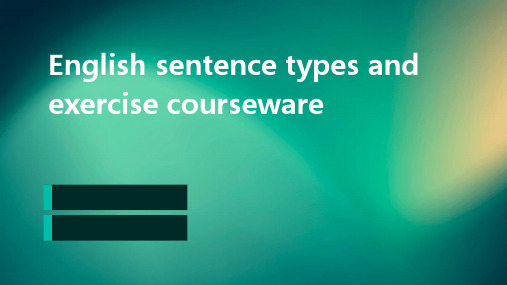
Summary Exercise 1 Exercise 2 Exercise 3
This exercise explores the most complex presence structure, which includes both direct and direct objects
Label the subject, predict, direct object, and direct object in each sentence
Summary
This exercise introduces the addition of an object to the subject predicate structure
Exercise 1
Identify the subject, predict, and object in each sentence
Summary
This exercise introduces the addition of an object to the subject predicate structure
Exercise 1
Identify the subject, predict, and object in each sentence
01
Summary
This exercise focuses on creating simple sentences with
a subject and predicate
03
Exercise 2
Fill in the blanks with the appropriate subject and predict to complete the
英语句子成分讲解(附练习和答案)ppt课件

主
谓
宾
9
主语 – 谓语动作的执行者
主语可以省略。
主语的形式结构:
– The sun rises in the east. (名词)
– He likes dancing. (代词)
– Twenty years is a short time in history. (数词)
– Seeing is believing. (动名词)
– To see is to believe.
(不定式)
– What he needs is a book. (主语从句)
– It is very clear that the elephant is round and tall like a tree.
10
宾语 –动作的承受者
• 动宾
– I like China. (名词) – He hates you. (代词) – How many do you need? We need two. (数词) – We should help the old and the poor. – I enjoy working with you. (动名词) – I hope to see you again. (不定式) – Did you write down what he said? (宾语从句)
初中英语句子结构讲解及练习题教案

初中英语句子结构讲解及练习题教案第一章:英语句子的基本成分1.1 英语句子的构成主语谓语宾语定语状语1.2 句子成分的练习题1. 填空题:选出正确的主语、谓语、宾语、定语、状语。
2. 改错题:找出并改正句子中的错误成分。
第二章:简单句的类型2.1 陈述句定义结构例子2.2 疑问句定义结构例子2.3 祈使句定义结构例子2.4 感叹句定义结构例子2.5 简单句练习题1. 选择题:判断句子属于哪种简单句类型。
2. 改写题:将陈述句改写为疑问句、祈使句、感叹句。
第三章:并列句3.1 并列句的定义和结构并列句的定义并列句的结构3.2 常用的并列连词并列连词的定义并列连词的例子3.3 并列句的练习题1. 填空题:使用适当的并列连词填空。
2. 改写题:将句子改写为并列句。
第四章:复合句4.1 复合句的定义和结构复合句的定义复合句的结构4.2 常用的从句连接词从句连接词的定义从句连接词的例子4.3 复合句的练习题1. 填空题:使用适当的从句连接词填空。
2. 改写题:将句子改写为复合句。
第五章:句子结构的应用5.1 句子结构的实际应用句子的连贯性句子的多样性5.2 句子结构练习题1. 改写题:根据要求改写句子,提高句子的连贯性和多样性。
2. 作文题:运用所学句子结构编写短文。
第六章:被动语态6.1 被动语态的定义和结构被动语态的定义被动语态的结构6.2 被动语态的运用场合被动语态的常用情境6.3 被动语态的练习题1. 填空题:使用被动语态填空。
2. 改写题:将句子改写为被动语态。
第七章:虚拟语气7.1 虚拟语气的定义和结构虚拟语气的定义虚拟语气的结构7.2 虚拟语气的运用场合虚拟语气的常用情境7.3 虚拟语气的练习题1. 填空题:使用虚拟语气填空。
2. 改写题:将句子改写为虚拟语气。
第八章:句子分类8.1 陈述句定义结构例子8.2 疑问句定义结构例子8.3 祈使句定义结构例子8.4 感叹句定义结构例子8.5 句子分类练习题1. 选择题:判断句子属于哪种类型。
高中英语句子成分和句子类型讲解及配套练习(讲课用).docx
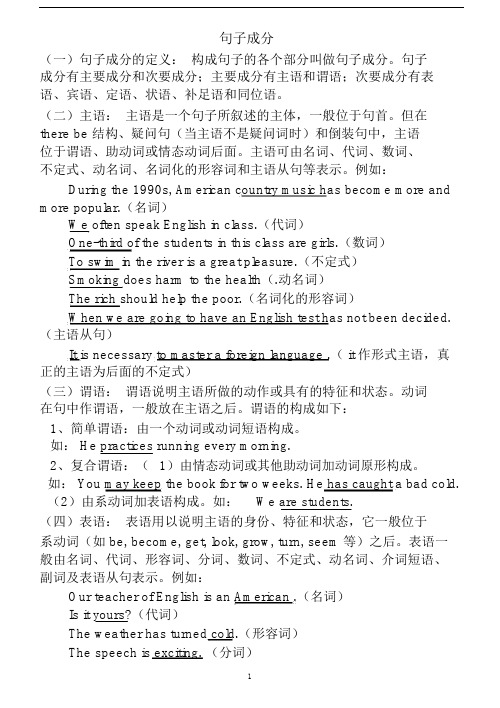
句子成分(一)句子成分的定义:构成句子的各个部分叫做句子成分。
句子成分有主要成分和次要成分;主要成分有主语和谓语;次要成分有表语、宾语、定语、状语、补足语和同位语。
(二)主语:主语是一个句子所叙述的主体,一般位于句首。
但在there be 结构、疑问句(当主语不是疑问词时)和倒装句中,主语位于谓语、助动词或情态动词后面。
主语可由名词、代词、数词、不定式、动名词、名词化的形容词和主语从句等表示。
例如:During the 1990s, American country music has become more and more popular.(名词)We often speak English in class.(代词)One-third of the students in this class are girls.(数词)To swim in the river is a great pleasure.(不定式)Smoking does harm to the health(.动名词)The rich should help the poor.(名词化的形容词)When we are going to have an English test has not been decided. (主语从句)It is necessary to master a foreign language .( it 作形式主语,真正的主语为后面的不定式)(三)谓语:谓语说明主语所做的动作或具有的特征和状态。
动词在句中作谓语,一般放在主语之后。
谓语的构成如下:1、简单谓语:由一个动词或动词短语构成。
如: He practices running every morning.2、复合谓语:(1)由情态动词或其他助动词加动词原形构成。
如: You may keep the book for two weeks. He has caught a bad cold.(2)由系动词加表语构成。
英语句子的种类及练习课件

英语句子练习方法与技 巧
句子结构分析方法
句子成分:主语、谓语、宾语、定语、状语、补语等 句子类型:简单句、并列句、复合句等 句子结构分析步骤:找主谓、找连词、找宾语、划分句子成分 句子结构分析技巧:注意连词的作用,识别并列句和复合句,理解句子意思
直译与意译 增译与减译 词性转换 语态转换
丰富内容:增加更多不同类型的英语句子练习,包括口语、写作、阅读等方面,帮助学生全面提 高英语能力。
个性化教学:根据学生的学习情况和需求,设计更加个性化的课件内容和教学方式,满足不同学 生的需求。
技术更新:不断跟进新技术和新媒体的发展,将最新的技术和手段融入到课件中,提高课件的质 量和效果。
感谢您的耐心观看
分类:时间状语从句、地点状语从句、原因状语从句、条件状语从句等
练习方法:通过选择题、填空题、改错题等方式进行练习
注意事项:注意从句的时态、语态和语气等问题,以及与主句的逻辑关系
复合句翻译练习
给出汉语句子,让学生翻译成英语复合句 给出英语复合句,让学生翻译成汉语句子 对比中英文复合句的结构和表达方式,让学生更好地理解两种语言的差异 通过实际练习,提高学生的翻译能力和语言运用能力
并列句
并列句的定义:由两个或两个以上的简单句用并列连词连接起来构成的句子。
并列句的构成:并列连词+简单句
并列句的分类:根据并列连词的不同,可以分为并列关系、转折关系、选择关系和因 果关系等。
并列句的练习方法:通过造句、翻译、改写等方式进行练习,提高对并列句的运用能 力。
复合句
定义:由一个主 句和一个或多个 从句构成的句子
主语+谓语+宾语
定义:主语+谓 语+宾语是构成 简单句的基本结 构
初中英语句子结构讲解及练习题教案

初中英语句子结构讲解及练习题教案第一章:英语句子的基本结构1.1 英语句子的主要成分主语谓语宾语定语状语1.2 简单句与复合句简单句:只含有一个主语和一个谓语的句子第二章:句子的分类2.1 陈述句用来陈述事实或状态的句子语气较为平静2.2 疑问句用来提问的句子语气较为疑问2.3 祈使句用来表达命令、请求或建议的句子语气较为坚决或客气2.4 感叹句用来表达惊喜、赞叹或抱怨的句子语气较为强烈第三章:句子成分的修饰关系3.1 定语用来修饰名词或代词的成分放在所修饰词之前3.2 状语用来修饰动词、形容词、副词或整个句子的成分放在所修饰词之后3.3 补语用来补充说明主语或宾语的成分放在所补充的词之后第四章:句子结构的变换4.1 主动句与被动句主动句:主语执行动作被动句:主语接受动作4.2 肯定句与否定句肯定句:表达肯定的意思否定句:表达否定的意思4.3 疑问句与陈述句的变换疑问句:将陈述句的语序调整为疑问语序陈述句:将疑问句的语序调整为陈述语序第五章:练习题5.1 选择题判断句子成分的正确性判断句子类型的正确性5.2 填空题根据语境填写适当的句子成分5.3 改写句子将主动句改为被动句将肯定句改为否定句5.4 翻译句子将英文句子翻译为中文5.5 写作练习运用所学句子结构知识,进行短文写作第六章:英语句子的时态6.1 一般现在时描述习惯性动作、普遍真理或状态6.2 一般过去时描述过去发生的动作或状态6.3 一般将来时描述将来会发生的动作或状态6.4 现在进行时描述正在进行的动作或状态6.5 过去进行时描述过去正在进行的动作6.6 现在完成时描述过去发生的动作对现在造成的影响6.7 过去完成时描述在过去某个时间点之前已经完成的动作第七章:英语语气的运用7.1 陈述语气用来陈述事实或意见7.2 疑问语气用来提问,期待对方的回答7.3 祈使语气用来发出命令、请求或建议7.4 感叹语气用来表达强烈的情感或意见第八章:复杂句型的运用8.1 定语从句用来修饰名词或代词,并在从句中作定语8.2 状语从句用来修饰动词、形容词、副词或整个句子,并在从句中作状语8.3 宾语从句用来作为动词或介词的宾语8.4 主语从句用来作为句子的主语8.5 表语从句用来作为句子的表语第九章:特殊句式9.1 倒装句将句子的主语和谓语颠倒位置9.2 省略句在句子中省略某些成分,使句子更简洁9.3 强调句用来强调句子的某个成分或意思9.4 被动句强调动作的承受者而非执行者第十章:练习题10.1 选择题判断句子时态的正确性判断句子语气的正确性10.2 填空题根据语境填写适当的时态或语气10.3 改写句子将简单句改为复杂句使用特殊句式改写句子10.4 翻译句子将英文句子翻译为中文10.5 写作练习运用所学句式知识,进行短文写作第十一章:介词和介词短语11.1 常见介词的用法介词的位置和宾语介词与名词、代词的搭配11.2 介词短语的构成和用法介词短语的构成介词短语在句子中的功能11.3 介词的辨析近义介词的用法区分介词在特定语境中的选择第十二章:代词和不定式12.1 代词的分类和用法人称代词、物主代词、反身代词等代词在句子中的指代功能12.2 不定式的构成和用法不定式的基本结构不定式在句子中的功能(如作状语、补语等)12.3 不定式的辨析不定式与现在分词、过去分词的区分不定式在特定语境中的使用第十三章:句子连接词和并列句13.1 句子连接词的分类和用法并列连接词、从属连接词等连接词在句子中的连接功能13.2 并列句的构成和用法并列句的基本结构并列句在句子中的并列功能13.3 并列句的练习使用并列连接词练习合并简单句为并列句的练习第十四章:间接引语和直接引语14.1 间接引语的构成和用法间接引语的基本结构间接引语在句子中的功能14.2 直接引语的构成和用法直接引语的基本结构直接引语在句子中的功能14.3 引语的辨析间接引语与直接引语的区分引语在特定语境中的选择第十五章:练习题15.1 选择题判断介词和介词短语的正确性判断代词和不定式的正确性15.2 填空题根据语境填写适当的介词、代词或不定式15.3 改写句子使用介词短语或代词改写句子将直接引语改为间接引语或反之15.4 翻译句子将英文句子翻译为中文15.5 写作练习运用所学知识,进行短文写作,如编写一个小故事、描述一个场景或说明一个过程,体现各种句子结构和时态的运用。
高考英语语法专项课件 句子成分、结构和种类 (85页PPT)+练习(含答案)

句子成分
(2)复合谓语
复合谓语是由“情态动词或助动词+动词”“ 系动词+表语”构成。
【例句】
eg:He can speak English very well. 他英语说得很好。ppy. 他似乎不高兴。
句子成分
3.表语
表语与系动词一起构成复合谓语,用 以说明主语 的性质、特征、状态或身份。表 语可由名词、代词、数词、形容词、副词、 分词、动名词(短语)、不定式(短语)、 介词短语或从句等充当。
句子成分、结构和种类
【备考2023】高考专项语法
目录
目录
Table Of Contents
01
02
03
04
句子成分
句子结构
句子种类
练习
句子成分
Part 01
句子成分
句子成分
组成句子的各个部分叫作句子成分。句子成分包括主语、谓语 、表语、宾语、定语、状语、补足语和同位语等。主语和谓语是句 子的主体部分,表语、宾语、定语、状语、补足语和同位语等是句 子的次要部分。
【例词】
d r e a m a terrible dream
做一个噩梦 die a glorious death 光荣牺牲
④同源宾语
同源宾语指少数不及物动词后,由名词担任的能重复动词部 分或全部意思的同源名词,名词前常有修饰语。
【例词】
smile a gentle smile 微微一笑 sing a sweet song 唱一首甜美的歌
句子成分
1.主语
主语是句子叙述的主体, 是谓语所表示的动作或状态的 执行者。主语可由名词(短语 )、代词、数词、不定式(短 语)、动名词(短语)或从句 等充当。
【例句】
英语句子分类讲解与专项练习

句子The Sentences知识要点:句子按使用的目的可分为四类:1、陈述句2、疑问句3、祈使句4、感叹句从结构上看句子可分为三种类型:1、简单句2、并列句3、复合句一、句子的种类(Kinds of Sentences)1、陈述句:(1)肯定句:We love our motherland. 我们热爱祖国。
(2)否定句:They don’t go to work on Sundays. 他们星期日不上班。
说明:叙述或否定一个事实或看法。
2、疑问句:(1)一般疑问句:Are you a worker? 你是个工人吗?Yes, I am. 是的,我是工人。
你没看过这部电影吗?没看过。
Haven’t you seen the film? No, I haven’t.说明:以一个助动词,情态动词或动词be开始的问句。
回答要用yes或no。
(2)特殊疑问句:Who is the man? 这人是谁?When do you watch TV? 你什么时间看电视?What are they doing now? 他们现在正在干什么?说明:以一个疑问代词或疑问副词开头的句子一般要用倒装句语序(或称为疑问词加一般疑问句)(3)选择疑问句:Do you want tea or coffee? Either will do. 你要茶水还是要咖啡?哪种都行。
Does he learn Japanese or French? He learns French. 他学日语还是学法语?他学法语。
说明:提出两个或两个以上的情况,选择一个作为答案。
(4)反意疑问句:他们要去机场,是吗?They are going to the airpor t, aren’t they?You haven’t finished your homework, have you? 你没做完作业,是吗?说明:提出情况或看法问对方是否同意。
在陈述句后附加一个简短的疑问句,即前面句子肯定,后为否定;前面句子否定,后为肯定。
英语句子的种类及练习课件
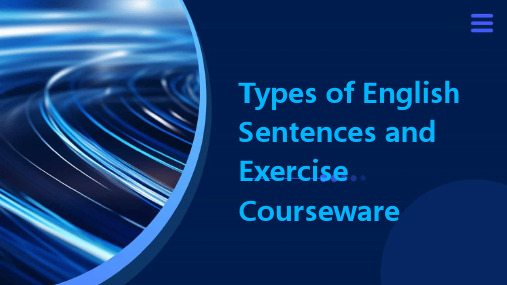
are, object: interesting)
03
Compound sentence
I enjoy reading books that are very interesting (Using the
attributive clause guided by 'that' to connect two simple
"She has a beautiful smile."
02
CATALOGUE
Compound presence
Definition
Compound sentence
A complete sentence formed by connecting two or more simple sentences with conjunctions.
A clause is a sentence used to modify a noun, pronoun, or the entire sentence in the main sentence.
Complex sentences are usually longer than simple sentences, containing more vocabulary and grammatical
Structure
1 2
Subject+predicate
This is the basic structure of a simple sentence, such as "I love English".
Subject+predicate+object
Add an object in a simple sentence, such as "I like reading books".
初中英语句子种类专项复习及解析(K12教育文档)
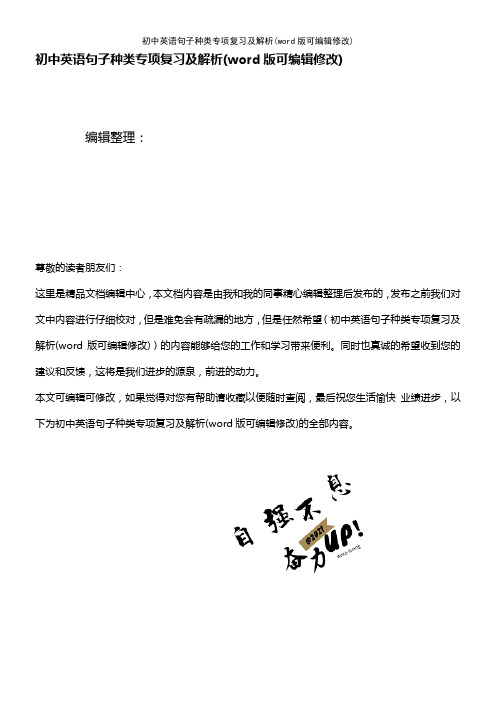
初中英语句子种类专项复习及解析(word版可编辑修改)编辑整理:尊敬的读者朋友们:这里是精品文档编辑中心,本文档内容是由我和我的同事精心编辑整理后发布的,发布之前我们对文中内容进行仔细校对,但是难免会有疏漏的地方,但是任然希望(初中英语句子种类专项复习及解析(word版可编辑修改))的内容能够给您的工作和学习带来便利。
同时也真诚的希望收到您的建议和反馈,这将是我们进步的源泉,前进的动力。
本文可编辑可修改,如果觉得对您有帮助请收藏以便随时查阅,最后祝您生活愉快业绩进步,以下为初中英语句子种类专项复习及解析(word版可编辑修改)的全部内容。
句子种类专项考点知识精讲按用途分,句子可分为四种:陈述句、疑问句、祈使句和感叹句。
考点一陈述句陈述句用来说明一个事实或陈述说话人的看法。
陈述句分为肯定式和否定式两种,句末用句号,读时用降调,有五种基本句型。
1.陈述句的肯定式的形式(1)主语+系动词+表语We are happy. 我们很快乐。
注:系动词有三类,具体如下:①表状态:be, seem, appear(显得),go(变成), stand(坐落),stay(保持), lie(位于),keep(保持)②表感官:look(看上去), sound(听起来),smell(闻起来), feel(感觉), taste(尝起来)③表变化:get(变得),become(成为), turn(变成),grow(渐渐变成),come(成为)(2)主语+不及物动词They are reading。
他们在看书。
(3)主语+及物动词+宾语I teach English。
我教英语.(4)主语+及物动词+间接宾语+直接宾语直接宾语表物,间接宾语表人。
一些间接宾语可改成一个由to引导的短语(强调动作是“向谁"做的),或由for 引导的短语(强调动作是“为谁"做的)。
He gave me a book.=He gave a book to me。
- 1、下载文档前请自行甄别文档内容的完整性,平台不提供额外的编辑、内容补充、找答案等附加服务。
- 2、"仅部分预览"的文档,不可在线预览部分如存在完整性等问题,可反馈申请退款(可完整预览的文档不适用该条件!)。
- 3、如文档侵犯您的权益,请联系客服反馈,我们会尽快为您处理(人工客服工作时间:9:00-18:30)。
英语句子分类讲解与专项练习句子The Sentences知识要点:句子按使用的目的可分为四类:1、陈述句2、疑问句3、祈使句4、感叹句从结构上看句子可分为三种类型:1、简单句2、并列句3、复合句一、句子的种类(Kinds of Sentences)1、陈述句:(1)肯定句:We love our motherland. 我们热爱祖国。
(2)否定句:They don’t go to work on Sundays. 他们星期日不上班。
说明:叙述或否定一个事实或看法。
2、疑问句:(1)一般疑问句:Are you a worker? 你是个工人吗?Yes, I am. 是的,我是工人。
Haven’t you seen the film? No, I haven’t. 你没看过这部电影吗?没看过。
说明:以一个助动词,情态动词或动词be开始的问句。
回答要用yes或no。
(2)特殊疑问句:Who is the man? 这人是谁?When do you watch TV? 你什么时间看电视?What are they doing now? 他们现在正在干什么?说明:以一个疑问代词或疑问副词开头的句子一般要用倒装句语序(或称为疑问词加一般疑问句)(3)选择疑问句:Do you want tea or coffee? Either will do. 你要茶水还是要咖啡?哪种都行。
Does he learn Japanese or French? He learns French. 他学日语还是学法语?他学法语。
说明:提出两个或两个以上的情况,选择一个作为答案。
(4)反意疑问句:They are going to the airport, aren’t they? 他们要去机场,是吗?You haven’t finished your homework, have you? 你没做完作业,是吗?说明:提出情况或看法问对方是否同意。
在陈述句后附加一个简短的疑问句,即前面句子肯定,后为否定;前面句子否定,后为肯定。
He seldom went to bed at ten, did he? 他很少在十点钟上床睡觉?是吗?He knows little Russian, does he? 他几乎不懂俄语,是吗?说明:当陈述句部分含有never, no, hardly, seldom, little等否定意义的副词时,附加问句用肯定形式。
3.祈使句:a.陈述句:Be sure to get there at eight. 八点钟一定要到那儿。
b.否定句:Don’t worry. I’ll help you out. 别担心,我会帮助你的。
说明:表示命令,请求,叮嘱,号召等,谓语动词用原形。
4.感叹句:感叹句通常有what, how引导,表示赞美、惊叹、喜悦、等感情。
what修饰名词,how 修饰形容词,副词或动词,感叹句结构主要有以下几种:掌握它的搭配,即掌握了感叹句的重点。
How +形容词+ a +名词+ 陈述语序。
例如:How clever a boy he is! 他是多聪明的孩子!How+形容词或副词+陈述语序。
例如:How lovely the baby is! 小毛头真可爱!What +名词+陈述语序。
例如:What noise they are making! 他们真吵!What +a/an+形容词+名词+陈述语序。
例如:What a clever boy he is! 他是多聪明的孩子!What+ 形容词+复数名词+陈述语序。
例如:What wonderful ideas (we have)! 我们的主意真棒!What+ 形容词+不可数名词+陈述语序。
例如:What cold weather it is! 多冷的天!What a clever boy he is!的省略形式为:What a clever boy!what + n.:What great changes we have had these years! 这几年我们有了多么大的变化啊!What a fine day it is! 多好的天呀!how + adj.:How brave he is! 他多么勇敢呀!how + adv. :How hard they are working! 他们工作多努力呀!How time flies! 时间过得多么快呀!How + adj. + a (an) + n.How nice a boy (he is)!=What a nice boy he is! 多么好的孩子啊!说明:表示说话时惊异,喜悦,气忿等情绪。
what修饰名词,how修饰形容词、副词或句子。
二、句子的类型(Types of Sentences)1、简单句的句子的类型:一个主语+一个谓语,例:The girl plays the piano every day. 那女孩每天弹钢琴。
两个主语+一个谓语,例:Tom and I are good friends. 汤姆和我是好朋友。
一个主语+两个谓语,例:He opened the door and left. 他打开门出去了。
两个主语或两个谓语或更多,例:Mr and Mrs Smith went to the market, bought some fruit and visited their friends. 史密斯夫妇去市场,买了些水果,并看望了朋友。
结构特殊:只含有一个词或一个词组,例:Hello! 喂!Help! Help! 救命啊!救命!Many thanks. 万分感谢。
2、简单句的基本句型(The Basic Sentence Patterns)句型结构:(1)主语+不及物动词:S + Vi.,例:Birds fly. 鸟飞They disappeared. 他们消失了。
(2)主 + 连系动词 + 表语:S + V + P,例:She is a university student. 她是一名大学生。
He has become a pilot. 他已成为一名飞行员。
(3)主 + 及物动词 + 宾语:S + Vt + O,例:He likes swimming. 他喜欢游泳。
We help each other. 我们互相帮助。
(4)主 + 及物动词 + 间接宾语 + 直接宾语:S + Vt + O + O,例:I told my friend the good news. 我把好消息告诉了我的朋友。
They sent us a telegram. 他们给我们拍了电报。
(5)主 + 及物动词 + 宾语 + 补语:S + Vt + O + C,例:They named the boy Jack. 他们给孩子起名叫杰克。
I want everything ready by eight o’clock. 我要求一切都要在八点前准备好。
注:S = Subject(主语)Vi=Intransitive Verbs(不及物动词)Vt=Transitive Verb(及物动词)P=Predicative(表语)O=Object(宾语)C=Complement补语重点、难点:否定陈述句要注意下列几点:(1)否定陈述句主要是在肯定句中加not或no (= not a /any) 构成的,除not和no外,用具有否定意义的副词也可构成否定陈述句。
常用的词有hardly, seldom, never, little, scarcely, barely, rarely 等。
(2)其他成分的否定形式有些句子的结构上属于肯定式,但含有否定意义的词,可分以下几种。
否定的主语:Nobody will agree with you. 没人同意你的意见。
None of the students like the novel. 没有学生喜欢这本小说。
No student here studies Russian. 这里没有一个学生学俄语。
否定的宾语:We saw nothing in the darkness. 在黑暗中我们什么都看不见。
He will borrow the book from nobody. 他从谁那都借不来这本书。
You must remember not to be late for class. 你必须记住上课不准迟到。
否定的状语:They came here not by bike but on foot. 他不是骑车来的而是走着来的。
We could find him nowhere. 我们什么地方也找不到他。
(3)不定代词all, both, everyone或everybody用于否定句时,表示部分否定。
All the trees here are not apple trees. ( = Not all the trees here are apple trees. )这里的树并非都是苹果树。
(有的是苹果树,有的不是。
)Both of the sisters are not nurses. ( = Not both of the sisters are nurses.)这姐儿俩并不都是护士。
Everybody can’t do it. (= Not ever ybody can do it. )并不是人人都能做这件事。
【专项训练】:一、陈述句和疑问句:1、They happy when they hear the news.A.will B.will be C.were D.don’t 2、——“ Is your uncle a driver?”——“.”A.No, but my aunt is B.Yes, but my anut isC.No, he doesn’t D.Yes, he does3、We satisfied with their work.A.don’t B.are not C.won’t D.weren’t being 4、He coffee at all. He tea.A.doesn’t like, prefers B.likes, doesn’t preferC.would like, not prefers D.prefers, is not fond of5、She me only twice since last year.A.sees B.was seeing C.has seen D.have seen 6、My grandma in the country. Now she in the city. A.used to live, lives B.used to living, livedC.uses to live, is living D.was used to live, lives7、You make such mistakes again.A.should never B.should not alwaysC.would always not D.would not forever8、“Can you drive a car?” “.”A.Yes, and Jim can’t too B.Yes, but Jim can’tC.No, but Jim can, too D.No, but Jim can’t9、“Are you going to the super market?” “ No, .”A.I cycle there B.I walk thereC.to the work D.I’ve already been there10、In England tea with milk or sugar in it.A.usually drinks B.is usually drunkC.usually is drunk D.drank usually11、“Is she going to the post office?” “No, .”A.she doesn’t B.she goes by bikeC.to the shops D.she’s on the bike12、Tom like reading at all. He interested in playing basketball. A.doesn’t, is B.doesn’t, were C.is, does D.was, is13、When home from work?A.do your parents come B.does your parents comeC.have your parents D.our parents come14、Which of the students the examination?A.not pass B.didn’t pass C.pass D.didn’t passed15、They trouble lifting the heavy box.A.didn’t have many B.hadn’t a lot ofC.didn’t have much D.haven’t a great deal of 16、——“Did you have breakfast this morning?——“.”A.Yes, I had B.Yes, I did C.No, I hadn’t D.No, I didn’t have.17、colour is the cover of the dictionary?A.What B.Which C.How D.Whose18、“does he brush his teeth a day?” “Twice.”A.What time B.How long C.When D.How many times19、There are many pictures on the wall.do you like best?A.What B.Which oneC.Which of the picture D.Which one picture20、Since when her?A.did you know B.have you knownC.do you know D.you know21、“That ten pound note belongs to me.” “.”A.Yes, it is B.Yes, it belongs C.No it doesn’t D.No, it isn’t 22、“Would you rather wait or come back later?” “.”A.I’d rather come back B.Yes, I’d rather not waitC.No, I’d rather wait D.to come back23、“shoes do you take?” “Size 42.”A.Which number B.What numberC.What size D.What24、“is the weather like today?” “ It’s windy.”A.What B.How C.What kind D.Which25、Would you read my composition and correct the mistakes, ?A.if have B.if any C.if ever D.if not26、is the distance between these two villages?A.How far B.What C.How long D.How much27、do you go to the cinema? Twice a month.A.How many time B.How muchC.How long D.How often28、How it in English?A.you say B.do you speak C.do you say D.to speak 29、is the population of the city?A.How much B.How many C.How D.What 30、did she get this information?A.Whom B.Who C.Where D.What31、does your watch cost? Two hundred yuan.A.How many B.What price C.What D.How expensive 32、About do you want to know more?A.Whom B.who C.which D.what 33、——We haven’t heard from Jane for a long time.——What do you suppose to her.A.was happening B.to happenC.has happened D.having happened34、——Have you heard the news about Jim?——No. What ?A.is it B.it is C.are they D.they are 35、——Would you rather go there by train or by air?—— .A.Yes, I would B.No, I wouldn’tC.Yes, by air D.By air36、I go or you go yourself?A.Will…will B.Shall…shall C.Shall…willD.Will…shall37、——Do you think the question easy or not?—— .A.Yes, I do B.No, I don’t C.It is easy D.Yes, it’s ea sy 38、Shall we stay at home or to the park?A.to go B.going C.go D.will go39、writer is better known in China, Charles Dickens or Mark Twain? A.Whichever B.Whether C.What D.Which40、——was the Nanjing-Changjiang Bridge open to traffic?——It was open to traffic in 1968.A.What B.What time C.How long D.When二、感叹句、祈使句41、from Beijing to London!A.How long way it is B.What a long way it isC.What a long way is it D.How long a way is it42、Oh, John, you gave us!A.How a pleasant surprise B.How pleasant surpriseC.What a pleasant surprise D.What pleasant surprise43、terrible weather we’ve been having these days!A.How a B.What a C.How D.What44、girl she is!A.What bright a B.How a brightC.How bright an D.What a bright45、we have today?A.How fine day B.What fine dayC.How a fine day D.What a fine day46、How flowers are!A.beautiful B.beautifullyC.beautiful the D.beautiful that 47、How !A.does time fly B.times fly C.time flies D.flies time 48、What work he does!A.harder B.hard C.hardly D.hardest49、careful our monitor is!A.How a B.How C.What a D.What50、advice he gave us!A.What a B.How good C.What good D.How51、picture it is!A.What wonderful B.How a wonderfulC.What wonderful a D.How wonderful a52、I wish to pay a visit to Hongkong!A.How do B.What do C.What D.How 53、hardworking students they are!A.What B.What a C.What an D.How 54、long time it lasted!A.What B.What a C.How D.How a 55、down the radio. The baby’s sleeping in the next room. A.Turning B.To turn C.Turn D.Turned 56、Let’s football in the street.A.not to playB.not play C.don’t play D.not playing57、careful when you cross the street.A.Don’t be B.Do be C.Being D.Do 58、the child all day long!A.Let, not to cry B.Not let, cry C.Don’t let, to cry D.Don’t let, cry59、afraid of make mistakes!A.Don’t be B.Not to be C.Not being D.Be not60、me again before coming.A.Calling B.To call C.Do calling D.Call三、反意疑问句61、You’d like some coffee, ?A.weren’t you B.wouldn’t you C.hadn’t you D.shouldn’t you 62、I don’t think he will come to the meeting, ?A.will he B.won’t he C.do I D.am I 63、Harry and his brother promised to work harder, .A.do they B.don’t they C.did they D.didn’t they64、His father knows little about it, he?A.does B.doesn’t C.is he D.isn’t65、We all like reading story books, ?A.do we B.do you C.don’t we D.don’t you66、My sister seldom goes to the theatre she?A.doesn’t B.does C.is D.isn’t67、Your father promised to buy a computer for you, he? A.often, did B.never, didn’t C.already, did D.never, did 68、Be sure to write to us, ?A.will you B.aren’t you C.would you D.can you69、Don’t s moke in the meeting room, you?A.do you B.will you C.would D.can70、It’s fine today. Let’s go fishing, ?A.will we B.shall we C.do we D.don’t we71、Mary has few friend in Japan, she?A.has B.don’t C.doesn’t D.hasn’t 72、There is a beautiful lake in this city, ?A.isn’t it B.isn’t there C.is it D.hasn’t it73、There is nothing wrong with my bike, ?A.is it B.isn’t there C.isn’t it D.is there74、He comes late sometimes, ?A.isn’t he B.comes he C.doesn’t he D.is he75、——You are not a new comer, are you?——. I came here only yesterday.A.No, I am B.Yes, I am C.No, I’m not D.Yes, I’m not. 76、She could hardly believe it, ?A.couldn’t she B.could she C.didn’t she D.did she77、You needn’t go, ?A.can you B.must you C.need you D.may you78、You must work hard from now on, ?A.can you B.won’t you C.mustn’t you D.needn’t you79、After walking so long a way, you must have been tired, you? A.were B.have C.haven’t D.mustn’t80、He must have left home yesterday, he?A.hasn’t B.didn’t C.mustn’t D.needn’t81、You don’t think I’m going out in such wet weather, ?A.am I B.do you C.don’t you D.do I82、You’d better call in a doctor for your mother, you?A.had B.would C.hadn’t D.wouldn’t 83、You need to come earlier, you?A.don’t you B.needn’t C.don’t D.won’t84、You dare not go alone, you?A.don’t B.do C.dare D.daren’t 85、He shouldn’t drink so much, he?A.should B.ought C.would D.will86、Nothing can stop us doing that, ?A.can we B.can’t we C.can’t it D.can it87、I’m late for the meeting, ?A.amn’t I B.aren’t I C.don’t I D.aren’t you88、Nobody but I knows Japanese in my class, ?A.does he B.doesn’t he C.do they D.don’t they89、None of the workers attended the party, ?A.did they B.did he C.didn’t he D.didn’t they 90、Everything is right here, ?A.isn’t it B.aren’t they C.are they D.is it91、A lovely day, ?A.is it B.does it C.isn’t it D.doesn’t it 92、He isn’t a diligent boy, for it is the second time he has been late, ? A.isn’t it B.is he C.has he D.is it93、My sister often needs help with her study, ?A.need she B.needn’t she C.doesn’t she D.does she94、You should have watered the flower earlier, ?A.shouldn’t you B.di dn’t you C.don’t you D.haven’t you95、Learning a foreign language well is not easy, ?A.is it B.isn’t it C.does it D.doesn’t it 96、What a pretty girl, ?A.isn’t it B.is it C.is she D.isn’t she97、Wang Ping can’t be in the bedroom, ?A.can she B.is she C.can’t he D.isn’t he 98、I wish to visit the Palace Museum next week, ?A.do I B.Shall I C.may I D.can I 99、Let us do it for you, ?A.will you B.won’t you C.shall we D.shan’t we100、They have to face the difficulty, they?A.do B.don’t C.haven’t D.won’t【答案】:1、B2、A3、B4、A5、C6、A7、A8、B9、D 10、B 11、C 12、A 13、A 14、B 15、C 16、B 17、A 18、D 19、B 20、B 21、C 22、A 23、C 24、A 25、B 26、B 27、D 28、C 29、D 30、C 31、C 32、A 33、C 34、A 35、D 36、C 37、C 38、C 39、D 40、D 41、B 42、C 43、D 44、D 45、D 46、C 47、C 48、B 49、B 50、C 51、D 52、D 53、A 54、B 55、C 56、B 57、B 58、D 59、A 60、D 61、B 62、A 63、D 64、A 65、C 66、B 67、D 68、A 69、B 70、B 71、A 72、B 73、D 74、C 75、B 76、B 77、C 78、C 79、C 80、B 81、B 82、C 83、A 84、C85、A 86、D 87、B 88、C 89、A 90、A91、C 92、A 93、C 94、B 95、B 96、D97、B 98、C 99、A 100、B7.若选B 翻译为:你不能再一次经常犯这样的错误。
